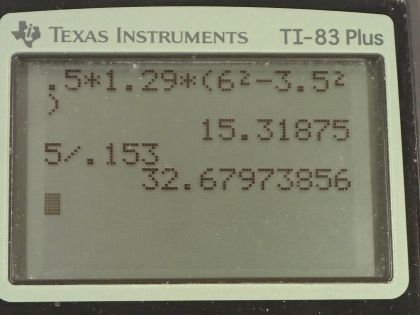Question
(a) Calculate the approximate force on a square meter of sail, given the horizontal velocity of the wind is 6.00 m/s parallel to its front surface and 3.50 m/s along its back surface. Take the density of air to be . (The calculation, based on Bernoulli’s principle, is approximate due to the effects of turbulence.) (b) Discuss whether this force is great enough to be effective for propelling a sailboat.
Final Answer
- This might be enough force. It would take 33 seconds for a 100kg boat to reach 5 m/s, for example. On the other hand, this neglects drag from the water. In any case, a bigger force could be obtained by using a larger sail or multiple sails.
Solution video
OpenStax College Physics for AP® Courses, Chapter 12, Problem 22 (Problems & Exercises)

vote with a rating of
votes with an average rating of
.
Calculator Screenshots
Video Transcript
This is College Physics Answers with Shaun Dychko. We're going to use Bernoulli's equation to figure out what is the force on this sail from the sailboat. So, this is the boat. And here's the mast holding up to sail. And the wind on the captain's side of the boat here where the skipper is is gonna be slow. V two is three and a half meters per second. And the wind on the other side of the sail this being the front of the boat is faster. And therefore, there'll be a smaller pressure there. And there'll be a force from the high pressure, slow air on this side towards the low pressure, fast air on the other side. I'm going to figure out what force that results in, given a one square meter area of the sail. So Bernoulli’s equation is this, pressure on this far side plus one half times the density of air times its speed squared plus rho g h one. This is the height of the air equals pressure on this near side of the sail. And you can see near this guy here, the skipper, P two plus one half rho times V two squared plus rho g h two. Now the height of the air here and here is the same. So these terms are you can subtract them both from both sides and they're equal. So they subtract zero. And then we can take P one over to the right hand side and then take one half rho V two squared to the left hand side. And then switched sides around and you have P two minus P one, this pressure difference between the two sides of the sail is one half time density of air times V one squared, minus one half density of air times V two squared. Then you can factor out one half density from both terms. So difference in pressure is also the the net forest divided by area. This is what pressure is force divided by area. And we can multiply both sides by A to figure out what the force is. So the force of the pressure difference times area, the pressure difference is this, which we substitute in for P two minus P one and so then we have the net forces one half times density of air of 1.29 kilograms cubic meter times six meters per second squared, speed on the far side of the sail, minus three and a half meters per second squared on the near side of the sail. And this is a force of 15.3 newtons. So that might be enough force if we make some assumptions that the boat is 100 kilograms and it's going to reach, say, five meters per second, starting from rest. Then the acceleration, which is a force divided by the mass, would be 0.153 meters per second squared. We'll see how long it takes if it's a reasonable amount of time to reach five meters per second given this acceleration. And we can use this kinematics equation, rearrange itself for t and that's five meters per second, minus zero divided by the acceleration, which is 33 seconds. And that's not bad. But this is an optimistic calculation because it assumes that there's no drag from the water. But a bigger sail could could be accomplished with a bigger sail. That's what real boats do. They got big sails. And that's why you get a little bit of force from each square meter. And it all adds up. Or you can have multiple sails as well.
